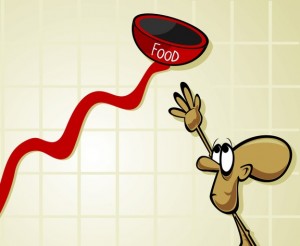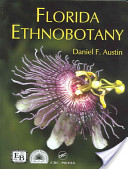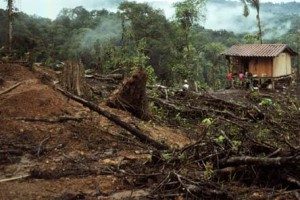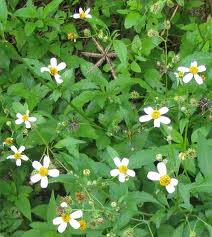Often I am asked “why forage for wild food?” Why that question is asked is probably worthy of an article unto itself. But here let’s focus on one answer (out of several.) Let’s look at cost.
The U.S. Bureau of Labor Statistics released recently their March number crunching. Food prices in March rose 2.4%, the sixth month in a row food prices have gone up, and the largest jump since 1984. But that’s counting everything. If you look at specific categories the numbers are more revealing.
 Fresh and dry vegetables went up 56.1%, fresh fruits and melons 28.8%, fresh eggs 33.6%, pork 19.1%, beef and veal up 10.7% and dairy products up 9.7%. All of that makes the Bidens alba growing in my yard all the more attractive, maybe even that pesky squirrel. Some think “food inflation” will continue even if the economy improves. Apparently that is what is happening in India now. Some investment gurus are talking about investing in, literally, food, and others like Warren Buffet are recommending investment in agriculture or countries with a lot of agriculture.
Fresh and dry vegetables went up 56.1%, fresh fruits and melons 28.8%, fresh eggs 33.6%, pork 19.1%, beef and veal up 10.7% and dairy products up 9.7%. All of that makes the Bidens alba growing in my yard all the more attractive, maybe even that pesky squirrel. Some think “food inflation” will continue even if the economy improves. Apparently that is what is happening in India now. Some investment gurus are talking about investing in, literally, food, and others like Warren Buffet are recommending investment in agriculture or countries with a lot of agriculture.
It’s interesting the price of plant products rose more than animal products, though animal products are also dependent on plants, however not necessarily plants that man grows. The difference is commercial plants for people need chemicals and tending whereas many plants for animals — range grass for example — do not, nor do most of the weeds we eat. However, contrary to what most folks think, foraging is not free. There are costs. Discounting time, one has to get to a place to forage. One has to transport the collected food and the food has to be cleaned. That requires some cost, from calories to bike tires to gasoline to clean water.
One also needs to know which plants to pick. That knowledge can come free, and/or from lessons, books, and internet services. My personal plant library of some six dozen books cost me about $1,000. You may never own more than one  foraging book, but my point is wild food is not totally free. But, it is the next thing to free, and the cost is much less than store-bought food and is less subject to inflation and taxes. Once you have foraging knowledge inside your head any cost gets prorated over time to the point of being negligible. A $20 course and a $30 book totals up to $50 but if you and yours can eat for a lifetime it’s a good investment. It’s also a certain measure of independence and security.
foraging book, but my point is wild food is not totally free. But, it is the next thing to free, and the cost is much less than store-bought food and is less subject to inflation and taxes. Once you have foraging knowledge inside your head any cost gets prorated over time to the point of being negligible. A $20 course and a $30 book totals up to $50 but if you and yours can eat for a lifetime it’s a good investment. It’s also a certain measure of independence and security.
 I’m not suggesting foraging as an answer to the growing food problem. With unemployment hovering near 17% (depending who’s counting and how they count) there are nearly 40 million Americans on food stamps, up 22.4% over this time last year. The government is now paying out more in benefits than it is taking in. At some point entitlement programs will be cut back. However, 40 million people can’t go out and forage even if they knew how. The impact on the environment would be devastating. The reality is not even one percent of the population (400,000 persons) are interested in foraging. I doubt that even one tenth of one percent (40,000 persons) are interested. Maybe one hundredth of one percent might be interested.
I’m not suggesting foraging as an answer to the growing food problem. With unemployment hovering near 17% (depending who’s counting and how they count) there are nearly 40 million Americans on food stamps, up 22.4% over this time last year. The government is now paying out more in benefits than it is taking in. At some point entitlement programs will be cut back. However, 40 million people can’t go out and forage even if they knew how. The impact on the environment would be devastating. The reality is not even one percent of the population (400,000 persons) are interested in foraging. I doubt that even one tenth of one percent (40,000 persons) are interested. Maybe one hundredth of one percent might be interested.
This we know: Food prices are rising, sharply. There is some cost associated with learning how to forage, and most people are not interested in foraging — at least not now. I think that adds up to a strong argument. Not only is it economical to forage, but it will be a steady food supply because others don’t see the value it represents. Even if they recognized its value today they are far behind you in the learning curve. Learning to forage can mean you have something to eat when they don’t. You certainly have more variety and better nutrition.
When you learn to forage you are doing more than identifying edible wild plants. You are also developing a skill and confidence. No matter how dire the need, those cannot be learned overnight. Foraging is like rigging, you learn mostly by doing and that cannot be rushed. You’re already way ahead of billions.


